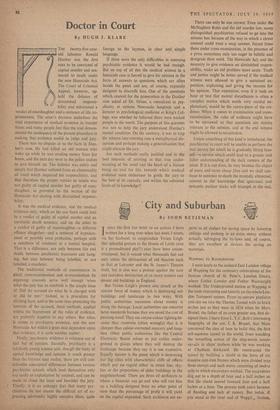City and Suburban
By JOHN BETJEMAN
ISENT the first fan letter to an actress I have written for a long time when last week 1 wrote, via her husband, to congratulate Vivien Leigh. Her splendid gesture in the House of Lords (was it a premeditated plot?) may have been uncon- stitutional, but it voiced what thousands feel not only about the destruction of old theatres such as that at Leicester and the St. James's Theatre itself, but it also was a protest against the sure and merciless destruction of so many modest and decent old buildings in England.
But Vivien Leigh's protest also struck at the sinister force of money which is destroying' our buildings and landscape in two ways. With public authorities meanness about money is doing the damage. Local authorities use concrete lamp standards because they are saved the cost of painting metal. They use corpse-colour lighting be- cause they maintain (often wrongly) that it is cheaper than colour-corrected mercury and tung- sten. Other public authorities like the Central Electricity Board refuse to put cables under- ground in places where they will destroy the landscape because they say it is too expensive. Equally sinister is the greed which is destroying our big cities with characterless cliffs of offices which pay no regard either to street line, sky- line or the proportions of older buildings in the neighbourhood. There are firms of architects to whom a financier can go and who will run him up a building designed from no other point of view than the percentage of profit it will yield on the capital expended. Such architects are ex-
perts in all dodges for saving space by lowering ceilings and pushing in an extra storey without actually infringing the by-laws and, of course, they are excellent at devices for saving on materials.
WAPPING TO ROTHERHITHE
I went lately to the isolated East London village of Wapping for the centenary celebrations of the famous church of St. Peter's, London Docks, where Father Lowder and Father Wainwright worked. The Underground station at Wapping is the most interesting and historic on the whole Lon- don Transport system. From its narrow platform you can see into the Thames Tunnel with its brick arches just as they were in 1824 when Sir Marc Brunel, the father of an even greater son, first de- signed them. I learn from L. T.C. Rolt's interesting biography of the son. 1. K. Brunel, that Marc conceived the idea of how to build this, the first sub-aqueous tunnel in the world, from watching the tunnelling action of the ship-worm t'redo navalis in ships' timbers while he was working at Chatham dockyard. He constructed the tunnel by building a shield in the form of six massive cast-iron frames which were divided into three storeys and each storey consisting of twelve cells in which excavators worked. The excavators dug out to a depth of four and a half inches so that the shield moved forward four and a half inches at a time. The process took years because of flooding and lack of money. But today, you stand at the river end of Wappir.,, Station,
you can see the light from Rotherhithe shining on the rails at the other end as the tunnel dips down under the bed of the river.
SCOTTISH FIVERS
Dismayed by the new English £5 note, which looks like worthless foreign money, I went to the Institute of Bankers to refresh my mind with the beauty of our old notes and of modern Scottish ones. There is a restful library in the institute and in it are volumes containing 50,000 different sorts of note from the earliest till today. There are also exhibits of forged notes and `skit notes'—that is to say, a note which looks exactly like, let us say, a Bank of England note for £50 and when you look at it closely you see it is for fifty pence. These were popular in the days of illiteracy for palming off on credulous rustics. Of the modern Scottish notes I think the best arc those of the National Bank of Scotland with the view of Princes Street on the back. They are printed in Edinburgh and are so highly coloured and so richly adorned with old-fashioned steel engraving of the best quality that they must be impossible to forge. The Commercial Bank of Scotland uses better paper and picturesque Geor- gian engraving and lettering. The North of Scot- land Bank note shows a delightful engraved view of the old King's College, Aberdeen. These at- tractive notes only fetch, I am told, 19s. 6d. in an English shop, though you can get it for them in a post office.















































 Previous page
Previous page